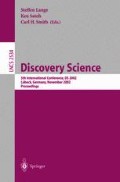Abstract
We apply multiple machine learning methods to obtain concise rules that are highly predictive of scientifically meaningful classes in hydrating plaster over multiple time periods. We use three dimensional data obtained through X-ray microtomography at greater than one micron resolution per voxel at five times in the hydration process: powder, after 4 hours, 7 hours, 15.5 hours, and after 6 days of hydration. Using statistics based on locality, we create vectors containing eight attributes for subsets of size 1003 of the data and use the autoclass unsupervised classification system to label the attribute vectors into three separate classes. Following this, we use the C5 decision tree software to separate the three classes into two parts: class 0 and 1, and class 0 and 2. We use our locally developed procedural genetic programming system, GPP, to create simple rules for these. The resulting collection of simple rules are tested on a separate 1003 subset of the plaster datasets that had been labeled with their autoclass predictions. The rules were found to have both high sensitivity and high positive predictive value. The classes accurately identify important structural comonents in the hydrating plaster. Morover, the rules identify the center of the local distribution as a critical factor in separating the classes.
Access this chapter
Tax calculation will be finalised at checkout
Purchases are for personal use only
Preview
Unable to display preview. Download preview PDF.
References
Kingrey, W. D., Bowen, H. K., Uhlmann, D. R.: Introduction to Ceramics. John Wiley and Sons, New York (1976)
Bullard, J. W.: Personal communication (2002)
Clifton, J. R.: Some aspects of the setting and hardening of gypsum plaster. Technical Note 755, NBS (1973)
Hand, R. J.: The kinetics of hydration of calcium sulphate hemihydrate: A critical comparison of the models in the literature. Cement and Concrete Research 24 (1994) 885–895
Ridge, M. J.: A discussion of the paper: The kinetics of hydration of calcium sulphate hemihydrate: A critical comparison of the models in the literature by r. j. hand. Cement and Concrete Research 25 (1995) 224
Hand, R. J.: A reply to a discussion by m. j. ridge of the paper: The kinetics of hydration of calcium sulphate hemihydrate: A critical comparison of the models in the literature. Cement and Concrete Research 25 (1995) 225–226
D. P. Bentz, S. Mizell, S. G. Satterfield, J. E. Devaney, W. L. George, P. M. Ketcham, J. Graham, J. Porterfield, D. Quenard, F. Vallee, H. Sallee, E. Boller, J. Baruchel: The Visible Cement Dataset. J. Res. Natl. Inst. Stand. Technol. 107 (2002) 137–148
Cheeseman, R., Kelley, J., Self, M., Taylor, W., Freeman, D.: Autoclass: A bayesian classification system. In: Proceedings of the Fifth International Conference on Machine Learning, San Francisco, CA, Morgan Kaufman (1988) 65–74
Cheeseman, P.: On finding the most probable model. In Shrager, J., Langley, P., eds.: Computational Models of Discovery and Theory Formation. Morgan Kaufman, San Francisco, CA (1991) 73–96
Stutz, J., Cheeseman, P.: Bayesian classification (autoclass): Theory and results. In Fayyad, U. M., Piatetsky-Shapiro, G., Smyth, P., Uthurusamy, R., eds.: Advances in Knowledge Discovery and Data Mining. AAAI Press, Menlo Park, CA (1995)
Kanefsky, B., Stutz, J., Cheeseman, P., Taylor, W., Clifton, J. R.: An improved automatic classification of a landsat/tm image from kansas (fife). Technical Report FIA-94-01, NASA AMES (1994)
Goebel, J., Volk, K., Walker, H., Gerbault, P., Cheeseman, P., Self, M., Stutc, J., Taylor, W.: A bayesian classifiection of the iras lrs atlas. Astronomy and Astrophysics 222 (1989) L5–L8
Reichenbach, H.: Atom and Cosmos. Dover Publications, Inc., Mineola, New York (1932) (First published in 1930 as Atom und Kosmos.).
Bentz, D. P.: Personal communication (2002)
Sattler, H., Bruckner, H. P.: Changes in volume and density during the hydration of gypsum binders as a function of the quantity of water available. ZKG International 54 (2001) 522
Quinlan, J. R.: C4.5: Programs for Machine Learning. Morgan Klauffann, San Mateo (1993)
Crow, E. L., Siddiqui, M. N.: Robust estimation of location. Journal of the American Statistical Associatiuon 63 (1967) 363–389
Koza, J. R.: Genetic Programming: On the Programming of Computers by Means of Natural Selection. MIT Press (1992)
Koza, J. R.: Genetic Programming II: Automatic Discovery of Reusable Programs. MIT Press (1994)
Koza, J. R., Andre, D., Bennett III, F. H., Keane, M.: Genetic Programming 3: Darwinian Invention and Problem Solving. Morgan Kaufman (1999)
Hagedorn, J., Devaney, J.: A genetic programming system with a procedural program representation. In: 2001 Genetic and Evolutionary Computation Conference Late Breaking Papers. (2001) 152–159 http://math.nist.gov/mcsd/savg/papers∼.
Devaney, J., Hagedorn, J., Nicolas, O., Garg, G., Samson, A., Michel, M.: A genetic programming ecosystem. In: Proceedings 15th International Parallel and Distributed Processing Symposium, IEEE Computer Society (2001) 131 http://math.nist.gov/mcsd/savg/papers∼.
Matthews, B. W.: Comparison of the predicted and observed secondary structure of t4 phage lysozyme. Biochimica et Biophysica Acta 405 (1975) 442–451
Monagan, M. B., Geddes, K. O., Heal, K. M., Labahn, G., Vorkoetter, S. M., McCarron, J.: Maple 6 Programming Guide. Waterloo Maple Inc., Waterloo, Ontario, Canada (2000)
Lathrop, R., Erbdster, T., Smith, R., Winston, P., Smith, T.: Integrating ai with sequence analysis. In Hunter, L., ed.: Aritifical Intelligence and Molecular Biology, Cambridge, MA (1993)
Meille, S., Garboczi, E. J.: Linear elastic properties of 2-d and 3-d modles of porous materials made from elongated objects. Mod. Sim. Mater. Sci 9 (2001) 1–20
Author information
Authors and Affiliations
Editor information
Editors and Affiliations
Rights and permissions
Copyright information
© 2002 Springer-Verlag Berlin Heidelberg
About this paper
Cite this paper
Devaney, J.E., Hagedorn, J.G. (2002). Discovery in Hydrating Plaster Using Machine Learning Methods. In: Lange, S., Satoh, K., Smith, C.H. (eds) Discovery Science. DS 2002. Lecture Notes in Computer Science, vol 2534. Springer, Berlin, Heidelberg. https://doi.org/10.1007/3-540-36182-0_7
Download citation
DOI: https://doi.org/10.1007/3-540-36182-0_7
Published:
Publisher Name: Springer, Berlin, Heidelberg
Print ISBN: 978-3-540-00188-1
Online ISBN: 978-3-540-36182-4
eBook Packages: Springer Book Archive

